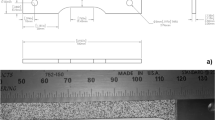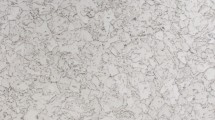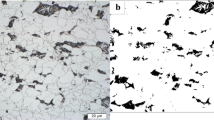Abstract
Application of a systems approach to computational materials design led to the theoretical design of a transformation toughened ultratough high-strength plate steel for blast-resistant naval hull applications. A first prototype alloy has achieved property goals motivated by projected naval hull applications requiring extreme fracture toughness (C v > 85 ft-lbs or 115 J corresponding to K Id≥ 200 ksi.in1/2 or 220 MPa.m1/2) at strength levels of 150–180 ksi (1,030–1,240 MPa) yield strength in weldable, formable plate steels. A continuous casting process was simulated by slab casting the prototype alloy as a 1.75′′ (4.45 cm) plate. Consistent with predictions, compositional banding in the plate was limited to an amplitude of 6–7.5 wt% Ni and 3.5–5 wt% Cu. Examination of the oxide scale showed no evidence of hot shortness in the alloy during hot working. Isothermal transformation kinetics measurements demonstrated achievement of 50% bainite in 4 min at 360 °C. Hardness and tensile tests confirmed predicted precipitation strengthening behavior in quench and tempered material. Multi-step tempering conditions were employed to achieve the optimal austenite stability resulting in significant increase of impact toughness to 130 ft-lb (176 J) at a strength level of 160 ksi (1,100 MPa). Comparison with the baseline toughness–strength combination determined by isochronal tempering studies indicates a transformation toughening increment of 65% in Charpy energy. Predicted Cu particle number densities and the heterogeneous nucleation of optimal stability high Ni 5 nm austenite on nanometer-scale copper precipitates in the multi-step tempered samples was confirmed using three-dimensional atom probe microanalysis. Charpy impact tests and fractography demonstrate ductile fracture with C v > 80 ft-lbs (108 J) down to −40 °C, with a substantial toughness peak at 25 °C consistent with designed transformation toughening behavior. The properties demonstrated in this first prototype represent a substantial advance over existing naval hull steels. Achieving these improvements in a single design and prototyping iteration is a significant advance in computational materials design capability.
Similar content being viewed by others
References
Saha, A., Olson, G.B. Computer-aided design of transformation toughened blast resistant naval hull steels: Part I. J. Comput.- Aided Mat. Design (2005) (Submitted)
Kuehmann C.J., Olson G.B. (1998) Gear steels designed by computer. Adv. Mater. Proc. 153, 40–43
Lippard H.E. (1999) Microanalytical investigations of transformation toughened Co-Ni steels. Doctoral dissertation. Northwestern University, Evanston, IL
Haidemenopoulos, G.N., Olson, G.B., Cohen, M. Dispersed-Phase Transformation Toughening in Ultrahigh-Strength Steels. In: Olson, G.B., Azrin, M., Wright, E.S. (eds.) Innovations in Ultrahigh-Strength Steel Technology (34th Sagamore Army Materials Research Conference), pp. 549–593. US Government Printing Office, Washington DC Lake George NY (1990)
Sebastian J.T. (2001) Nanoscale three-dimensional studies of segregation at ceramic/metal interfaces. Doctoral dissertation. Northwestern University, Evanston IL
Miller M.K., Smith G.D.W. (1977) Atom Probe Microanalysis: Principles and Applications to Materials Problems. MRS Publications, Pittsburgh, PA
Hellman O.C., Vandenbroucke J.A., Blatz du Rivage J., Seidman D.N. (2002) Application software for data analysis for three-dimensional atom probe microscopy. Mater. Sci. Eng. A 327, 29–33
Hellman O.C., Blatz du Rivage J., Seidman D.N. (2003) Efficient sampling for three-dimensional atom-probe microscopy data. Ultramicroscopy 95, 199–205
Hellman O.C., Vandenbroucke J.A., Rüsing J., Isheim D., Seidman D.N. (2000) Analysis of three-dimensional atom-probe data by the proximity histogram. Microsc. Microanal. 6, 437–444
Halley, J.W. Effect of residual elements upon the properties of metals. ASM 71–87 (1957)
Melford D.A. (1962) Surface hot shortness in mild steel. J. Iron Steel Inst. 200, 290–299
Seo S., Asakura K., Shibata K. (1997) Effects of 0.4% Si and 0.02% P additions on surface hot shortness in 0.1%C-0.5%Mn steels containing 0.5% Cu. ISIJ Int., 37, 240–249
Salter W.J.M. (1966) Effects of alloying elements on solubility and surface energy of copper in mild steel. J. Iron Steel Inst. 204, 478–488
Fisher G.L. (1969) The effect of nickel on the high-temperature oxidation characteristics of copper-bearing steels. J. Iron Steel Inst., 207, 1010–1016
Imai N., Komatsubara N., Kunishige K. (1997) Effect of Cu and Ni on hot workability of hot-rolled mild steel. ISIJ Int. 37, 224–231
Akamatsu S., Senuma T., Takada Y., Hasebe M. (1999) Effect of nickel and tin additions on formation of liquid phase in copper bearing steels during high temperature oxidation. Mater. Sci. Tech. 15, 1301–1307
Nicholson A., Murray J.D. (1965) Surface hot shortness in low-carbon steel. J. Iron Steel Inst. 203, 1007–1018
Ghosh G., Olson G.B. (1994) Kinetics of \({{{\rm FCC}} \to {{\rm BCC}}}\) heterogeneous martensitic nucleation-I. the critical driving force for athermal nucleation. Acta Mater. 42, 3361–3370
Maruyama N., Sugiyama M., Hara T., Tamehiro H. (1999) Precipitation and phase transformation of copper particles in low alloy ferritic and martensitic steels. Mater. Trans. JIM 40, 268–277
Foley R.P. (1992) Normal and intercritical tempering behavior of a low-carbon, copper-bearing steel designed for ultraservice applications. Doctoral dissertation. Northwestern University, Evanston IL
Grange R.A., Baughman R.W. (1956) Hardness of tempered martensite in carbon and low alloy steels. Trans. Am. Soc. Met. 48, 165–197
Hollomon J.H. (1945) Tensile deformation. Trans. Metall. Soc. AIME. 162, 268–290
Leal R.H. (1984). Transformation toughening of metastable austenitic steels. Doctoral dissertation. Department of Materials Science and Engineering, Massachusetts Institute of Technology, Cambridge MA
Gagliano, M.S. Co-precipitation of copper and niobium carbide in a low carbon steel. Doctoral dissertation. Northwestern University, Evanston IL (2002). Atom-probe experiments by D. Isheim
Russell K.C., Brown L.M. (1972) A dispersion strengthening model based on differing elastic moduli applied to the iron-copper system. Acta Metall. 20, 969–974
Isheim D. (2002) Unpublished research. Department of Materials Science and Engineering, Northwestern University, Evanston IL
Miller M.K. (1999) Atom Probe Tomography: Analysis at the Atomic Level. Kluwer Academic/Plenum Publishers, New York
Goodman S.R., Brenner S.S., Low J.R. (1973) An FIM-Atom probe study of the precipitation of copper from iron-1.4 At. Pct copper. Part II: Atom probe analyses. Metall. Trans. A 4, 2371–2378
Vurpillot F., Bostel A., Blavette D. (2000) Trajectory overlaps and local magnification in three-dimensional atom probe. App. Phy. Lett. 76, 3127–3129
Blavette D., Vurpillot F., Pareige P., Menand A. (2001) A model accounting for spatial overlaps in 3D atom-probe microscopy. Ultramicroscopy 89, 145–153
Miller, M.K., Cerezo, A., Hetherington, M.G., Smith, G.D.W. In Miller, M.K. (ed.) Atom Probe Field Ion Microscopy. Clarendon, Oxford UK, pp. 196–199 (1996)
Author information
Authors and Affiliations
Corresponding author
Rights and permissions
About this article
Cite this article
Saha, A., Jung, J. & Olson, G.B. Prototype evaluation of transformation toughened blast resistant naval hull steels: Part II. J Computer-Aided Mater Des 14, 201–233 (2007). https://doi.org/10.1007/s10820-006-9032-y
Published:
Issue Date:
DOI: https://doi.org/10.1007/s10820-006-9032-y




